What Is Keyword Intent?
Keyword intent, also known as search intent, is what searchers want to achieve after they conduct a specific search.
For example, when someone searches “buy orchid seeds,” the intent behind that search is probably to make a purchase.
But someone searching just “orchid seeds” might not want to make a purchase. It’s possible that they just want to learn more about orchid seeds.
Google’s goal is to answer searcher’s queries as efficiently as possible. So, if your content answers a keyword’s search intent, you’re more likely to rank for that keyword.
This is why it’s important to identify keyword intent before you create a piece of content to target a specific keyword.
Let’s elaborate on that.
Why Understanding Keyword Intent Is So Valuable in SEO
Understanding and addressing keyword intent will increase your chances of ranking for the keywords you want to target.
In other words, Google uses keyword intent to determine what should appear for which searches. So searchers can get to the pages that can best address their queries.
Let’s use the examples above to illustrate.
Someone searching for “buy orchid seeds” likely wants to make a purchase. So here’s what the results page looks like:
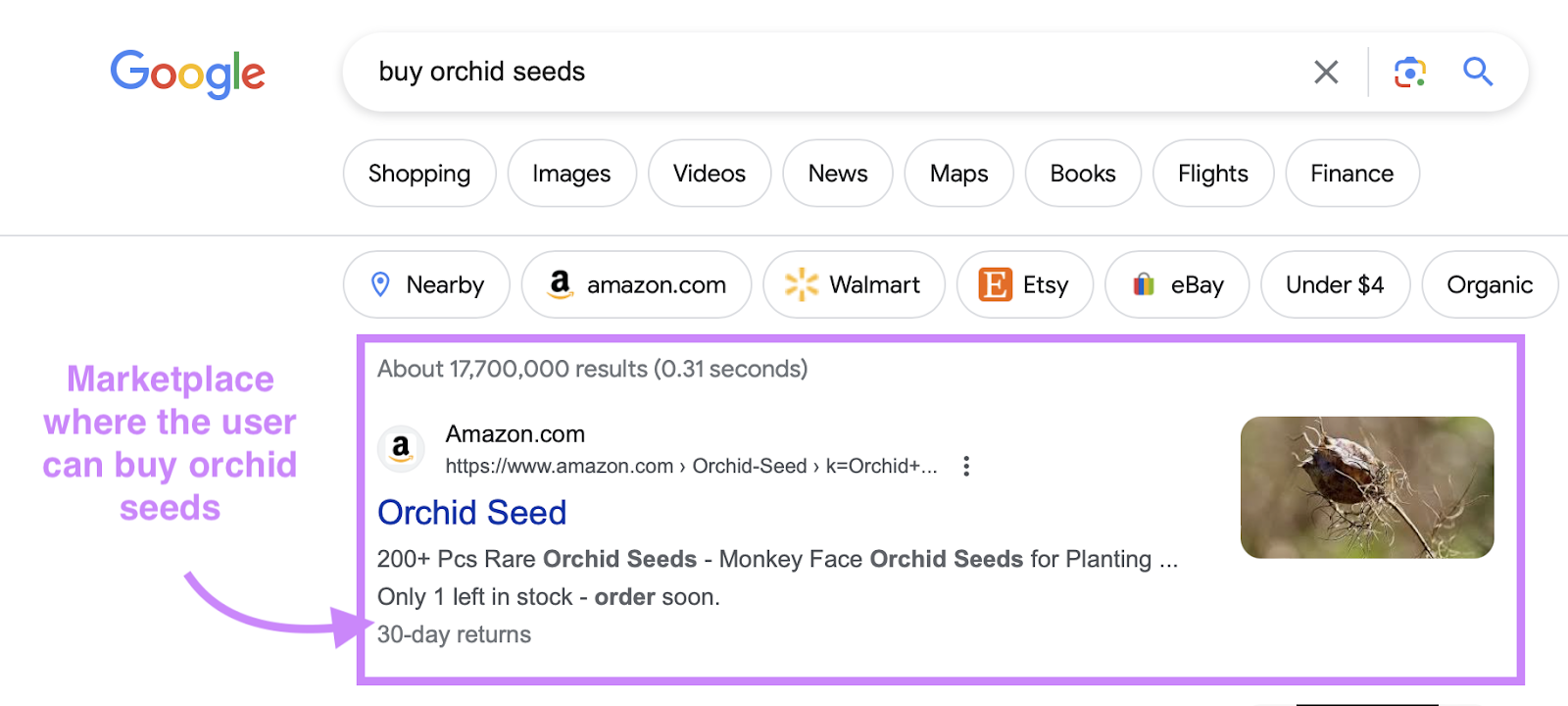
The first result is Amazon. Because Google knows the searcher wants to buy.
Someone searching for just “orchid seeds,” on the other hand, might want to buy. Or might want more information about orchid seeds.
So here’s what the results look like:
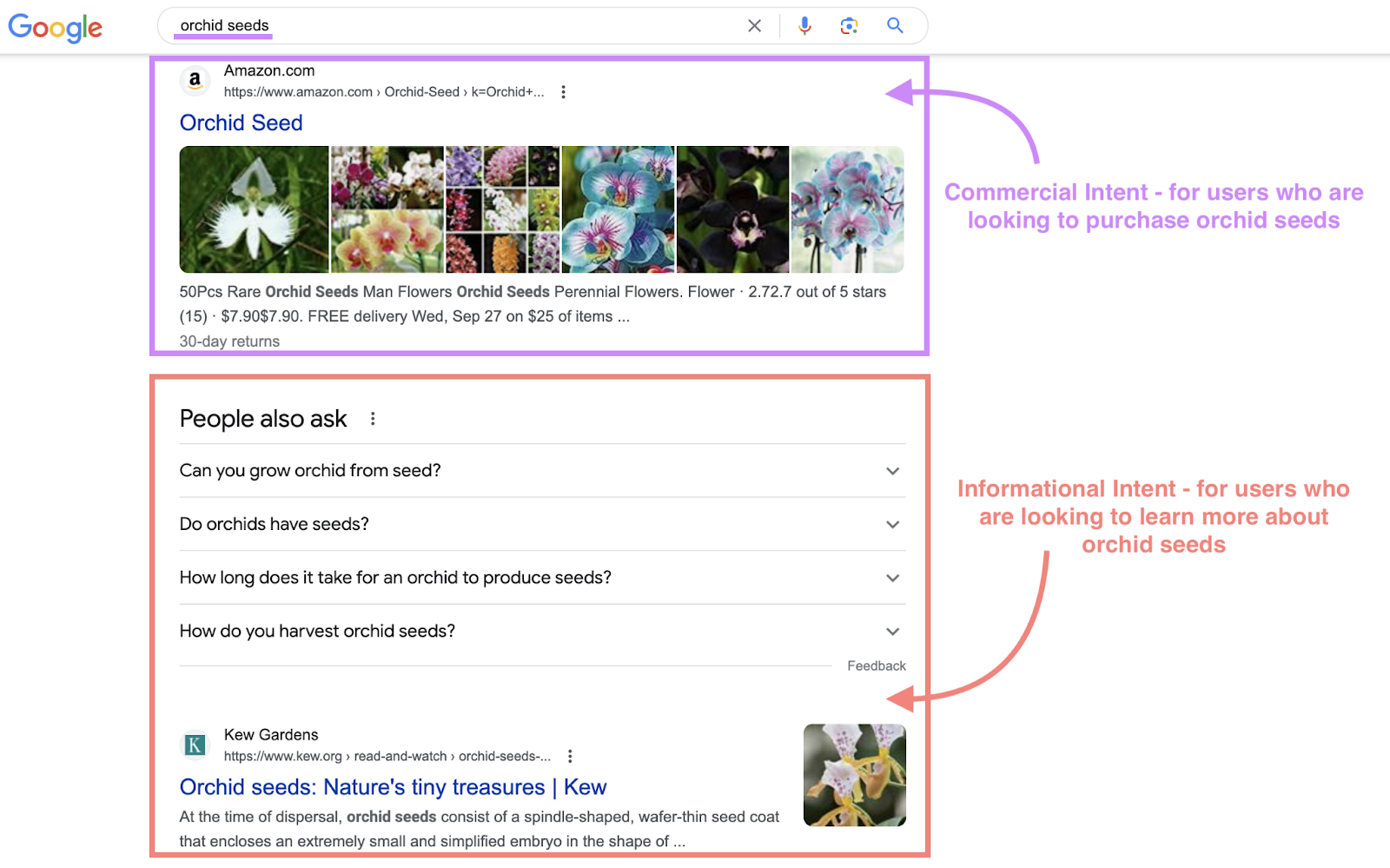
Amazon is still number one, to cover purchasing intent. But Google also surfaces articles that tell searchers more about orchid seeds. And how to grow them from scratch.
So, your complete guide to orchid seeds could rank for the “orchid seeds” keyword. But probably not for the “buy orchid seeds” keyword.
4 Types of Keyword Intent
There are four main keyword intent types:
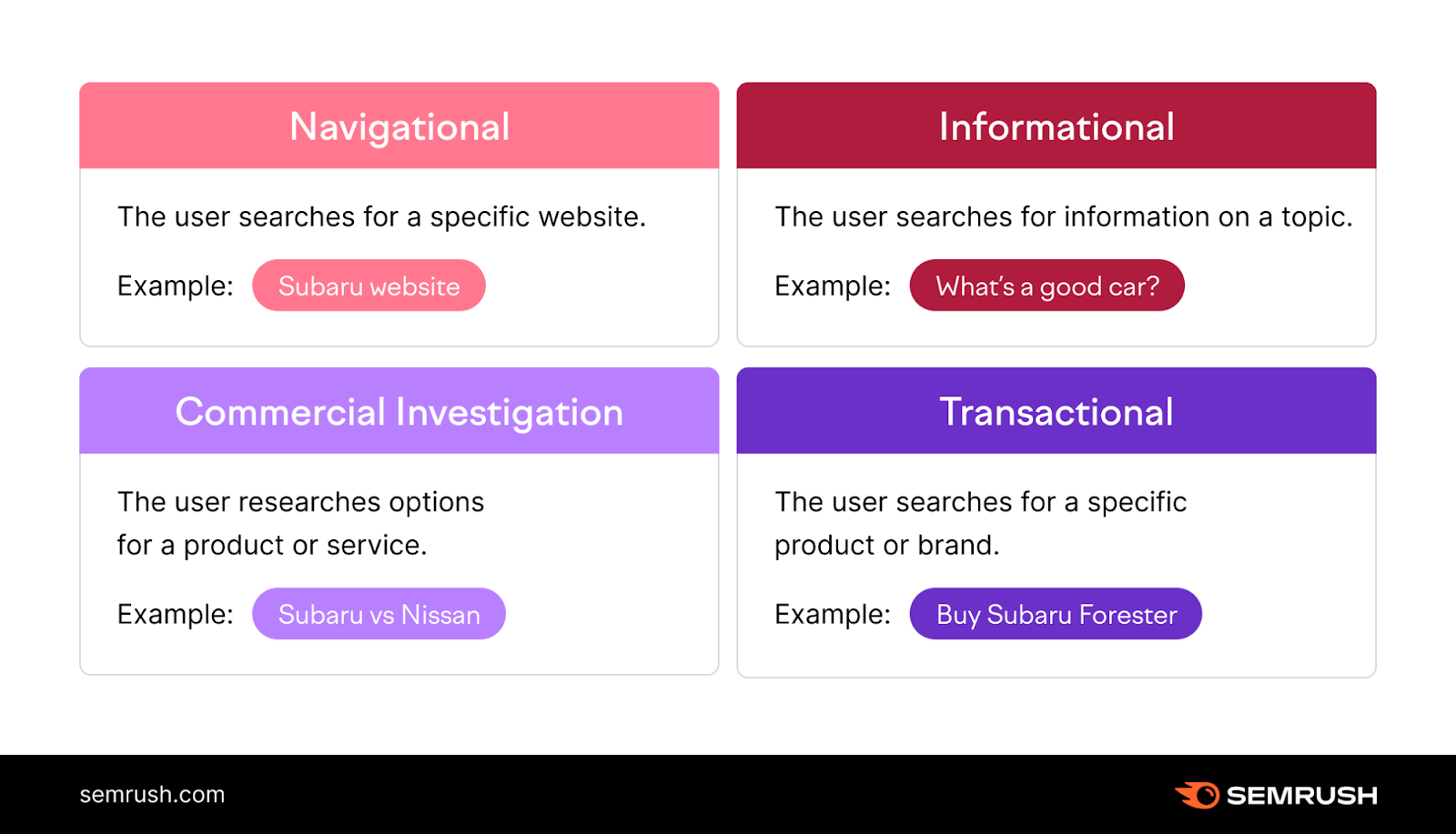
Let’s learn more about them.
Pro tip: Sign up for the Keyword Overview tool for free so you can look for the different types of keywords yourself.
1. Navigational Keyword Intent
Navigational keywords are used when the searcher wants to get to a specific page or website.
In this case, the user typically knows exactly what they’re looking for.
Here are some examples:
- Youtube
- Facebook login
- Amazon shipping policy
- Semrush keyword overview tool
- Mama’s little bakery chicago address
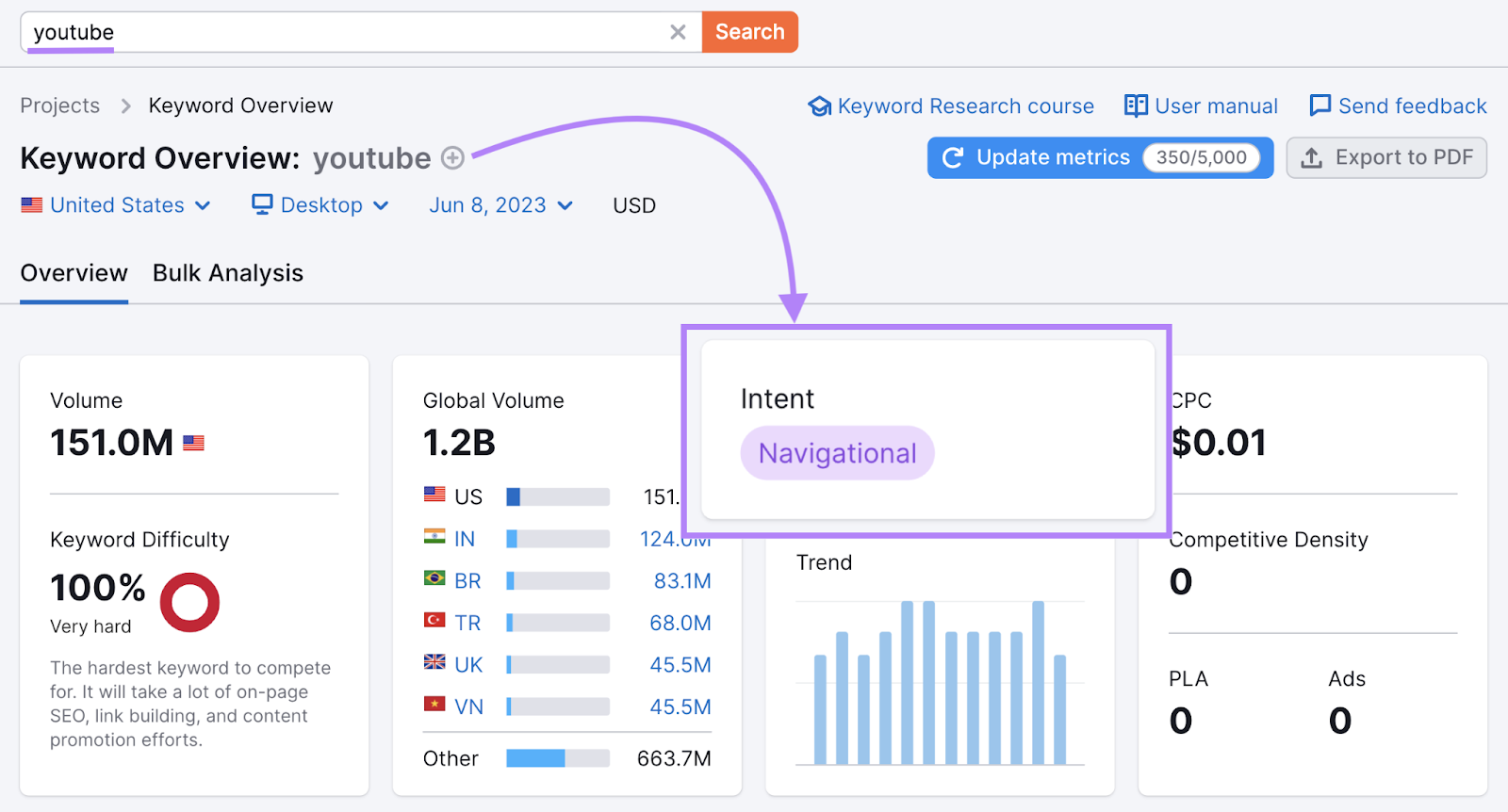
In general, navigational keywords are low intent. Meaning that the reader probably isn’t planning to make a purchase.
However, in some cases, they can lead to a business-related action.
For example, when someone searches for “semrush backlink audit tool,” they’re probably looking to use that tool.
They find the tool through search and then sign up for free. After using the tool, they may realize that they want to access more features. Which would lead to a transaction.
These keywords are usually branded. So, ranking for them is a bit easier.
2. Informational Keyword Intent
People use informational keywords when they want to learn something new.
These keywords can come in the form of questions and start with:
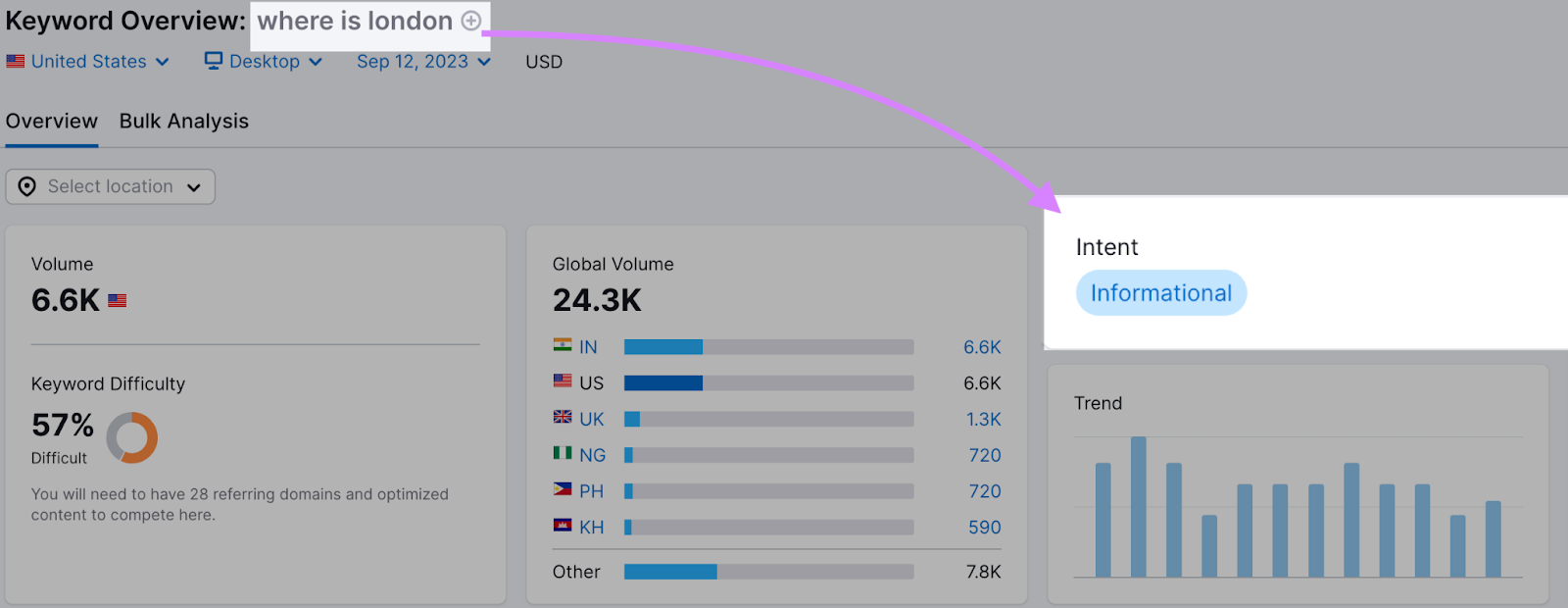
For example:
- What is link building
- How to change a lightbulb
- Where is nyc
But informational keywords don’t only come in question forms. They can also look like this:
- Pasta bolognese recipe
- Maldives time now
- Disavow backlinks
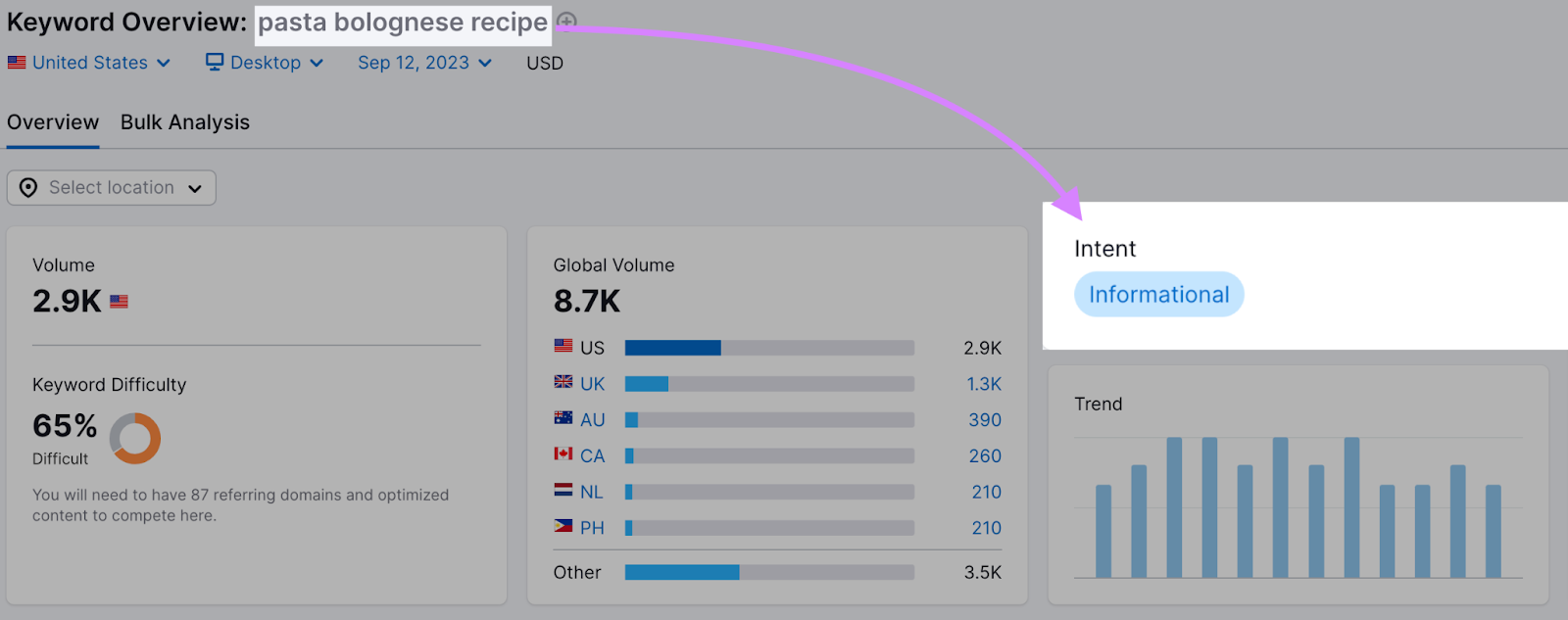
Informational keywords are also low intent.
But that shouldn’t discourage you from targeting these keywords.
Target informational keywords with:
- How-to blog posts
- Long-form articles
- Informational videos
- Infographics
By creating accurate informational and educational content, you establish yourself as a trustworthy source of information for your target audience.
Which means that they’ll likely come back to your website to learn more.
And if they ever become ready to make a purchase, they’ll already be familiar with your brand and your website.
3. Commercial Keyword Intent
People use keywords with commercial intent when they’re doing research before making a purchase.
The user isn’t ready to make a purchase just yet.
They need a little more information before hitting that “buy” button. Which is why commercial keywords are often branded.
Here are some examples of branded commercial keywords:
- Macbook pro vs macbook air
- HARO alternatives
- Semrush reviews
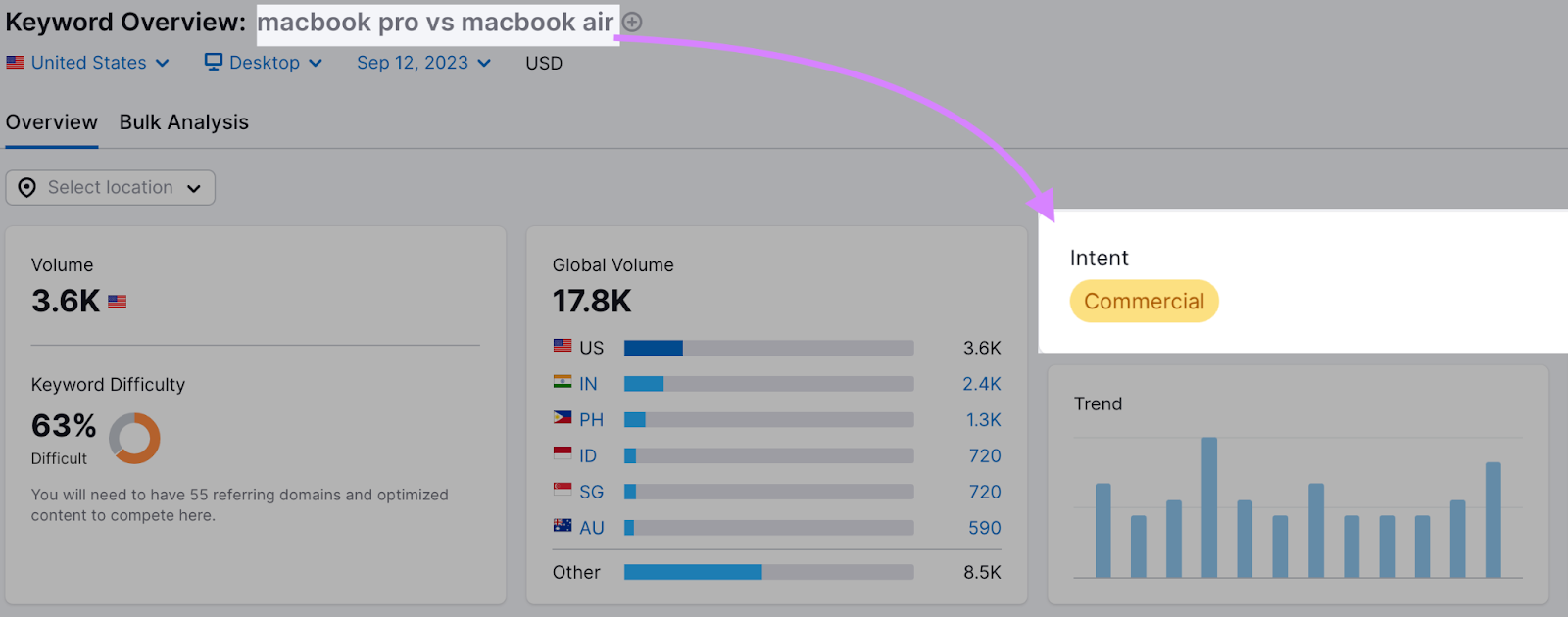
But they can also be unbranded, like:
- Best running shoes
- Custom birthday cakes
- Wedding dresses
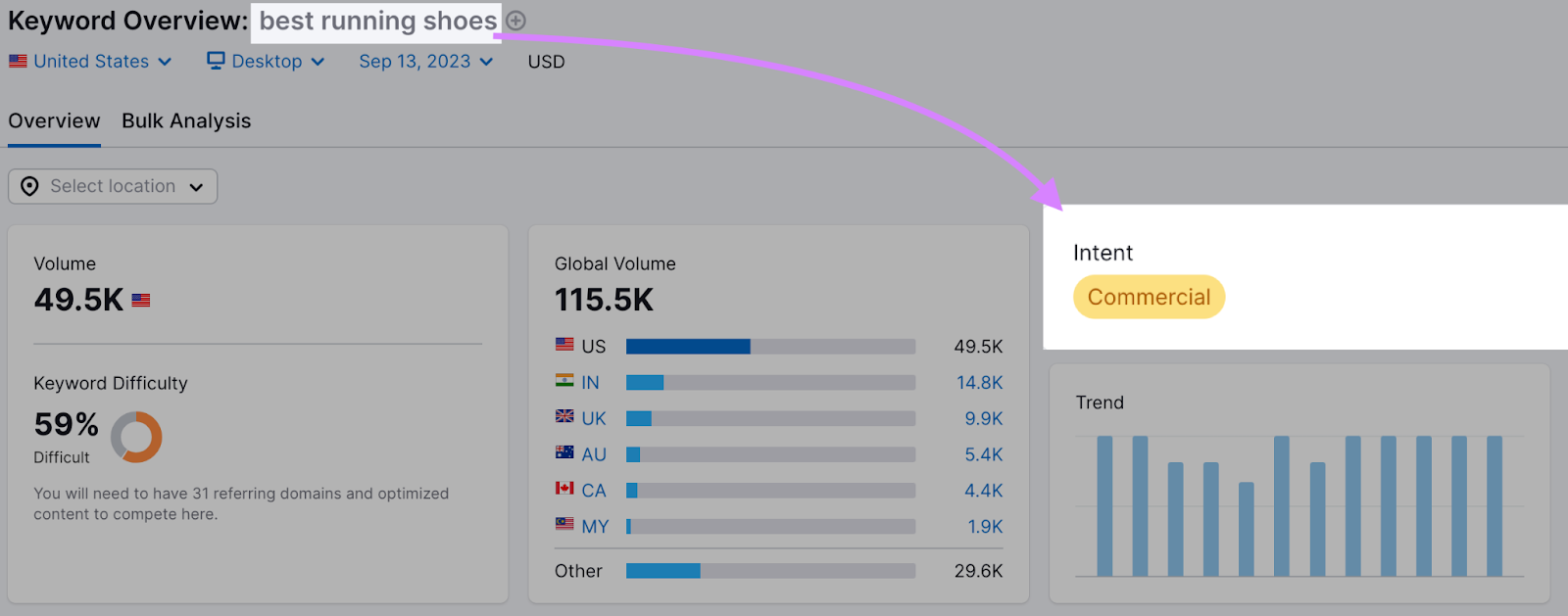
As you can see, commercial keywords can often include some of these words:
- Vs
- Alternatives
- Reviews
- Comparison
- Best
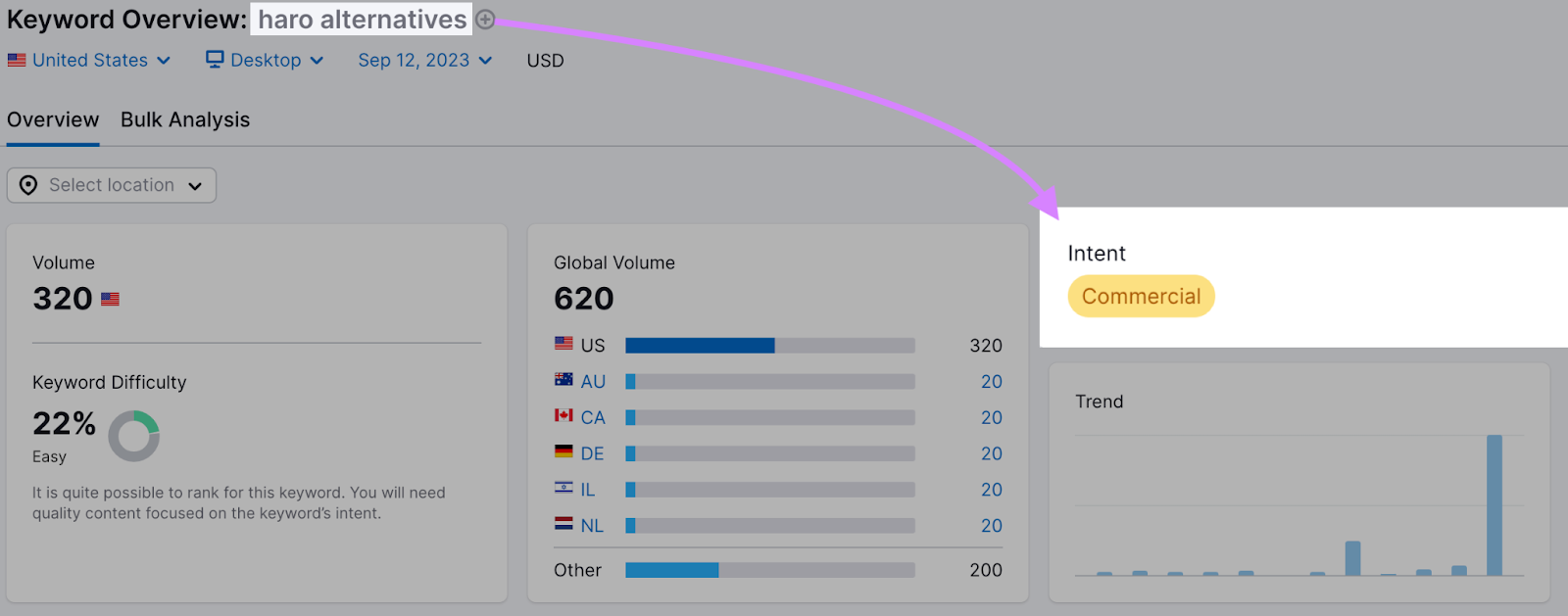
Commercial keywords are high-intent keywords.
That means there’s a higher chance that the user will take a business action. Most likely, make a purchase.
Target commercial keywords with:
- Product/service landing pages
- Comparison articles
- Testimonials and reviews
4. Transactional Keyword Intent
People who use transactional keywords are ready to make a purchase. Or subscribe to your services.
Let’s have a look at a list of buyer intent keywords:
- Semrush promo code
- Buy audi tt
- Italian restaurants near me
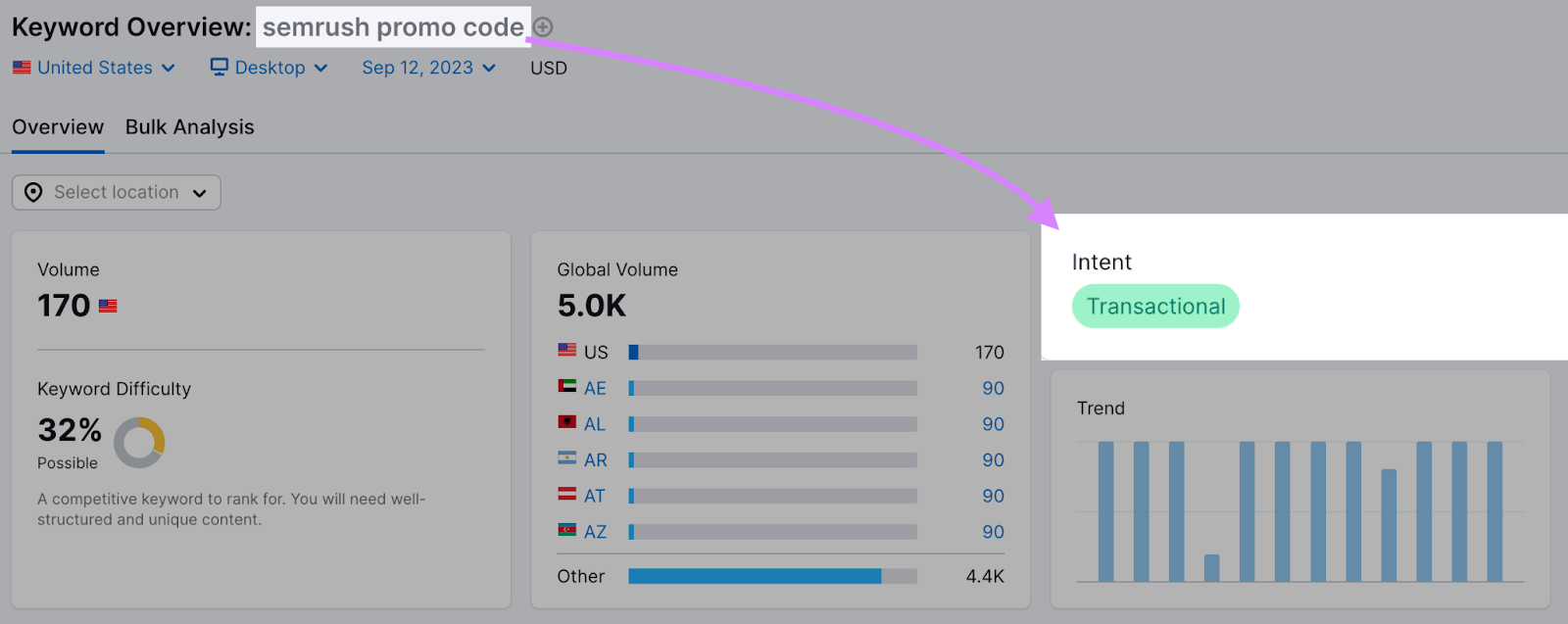
As you can see, the users are ready to do or buy something.
Which is why transactional keywords have the highest intent out of all four types of keywords. And that transactional keywords have the highest impact on your conversion rate.
Target transactional keywords with the following types of content:
- Subscription or signup pages
- Deals and coupons pages
- Product/service pages
- Free trial pages
Conversions aren’t always sales. Conversions can also mean subscribing to your newsletter, booking a discovery call, or filling out a questionnaire.
Side note: Transactional keywords are also important for PPC (pay-per-click) strategies. To learn more about PPC and how it differs from SEO, read our PPC guide.
How to Identify Keyword Intent Using Semrush
Find the intent behind each keyword in seconds with our Keyword Research tools.
Here’s how.
Use the Keyword Overview Tool to Find the Right Keywords to Target
Instead of manually trying to figure out keyword intent, use a keyword research tool.
Let’s use “amazon shipping policy” for this walkthrough.
Go to the Keyword Overview tool.
Type in the keyword “amazon shipping policy.” And click on “Search.”

You’ll immediately see the search intent: “Navigational” and “Transactional.”
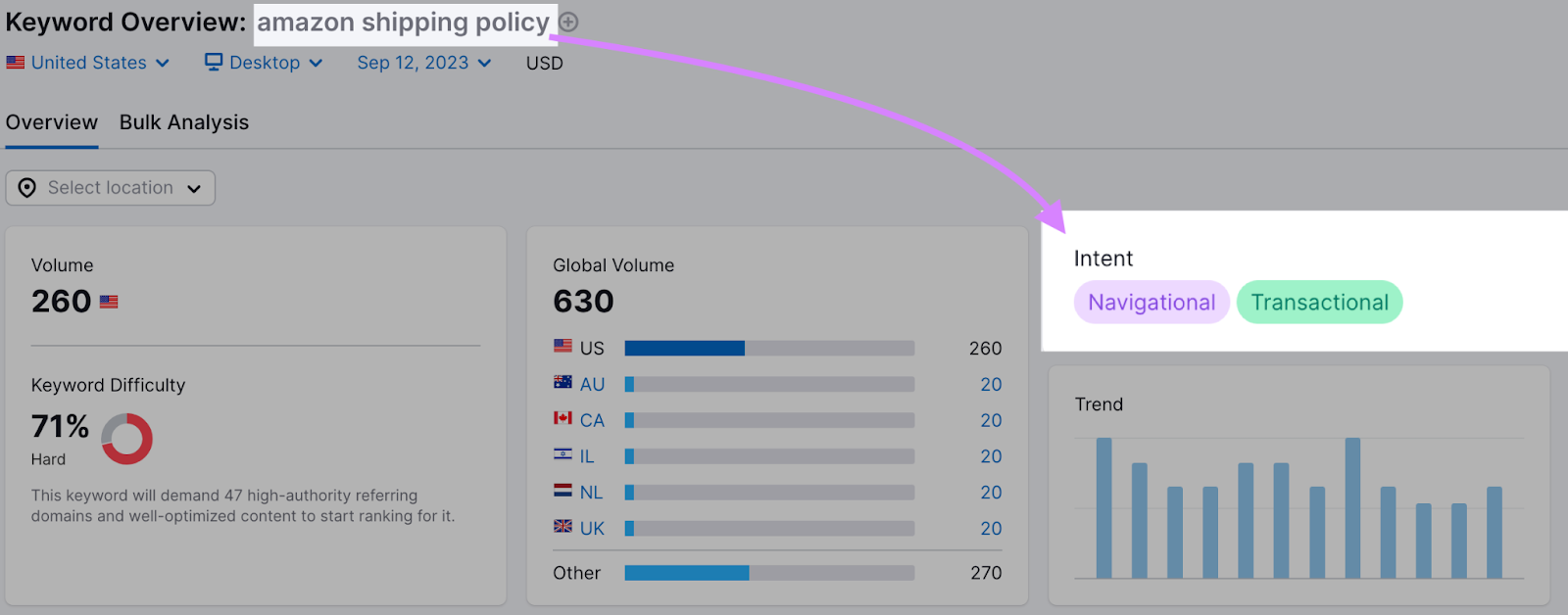
It’s navigational because a user is looking for a specific page on Amazon’s website.
And it’s transactional because they’re probably ready to buy something but want to check the shipping policy before they do.
This is a branded, high-intent keyword example.
Now, the next question is: Should you target that keyword?
Let’s see.
Scroll down to the “SERP Analysis” section to see the top 10 search results for that keyword.
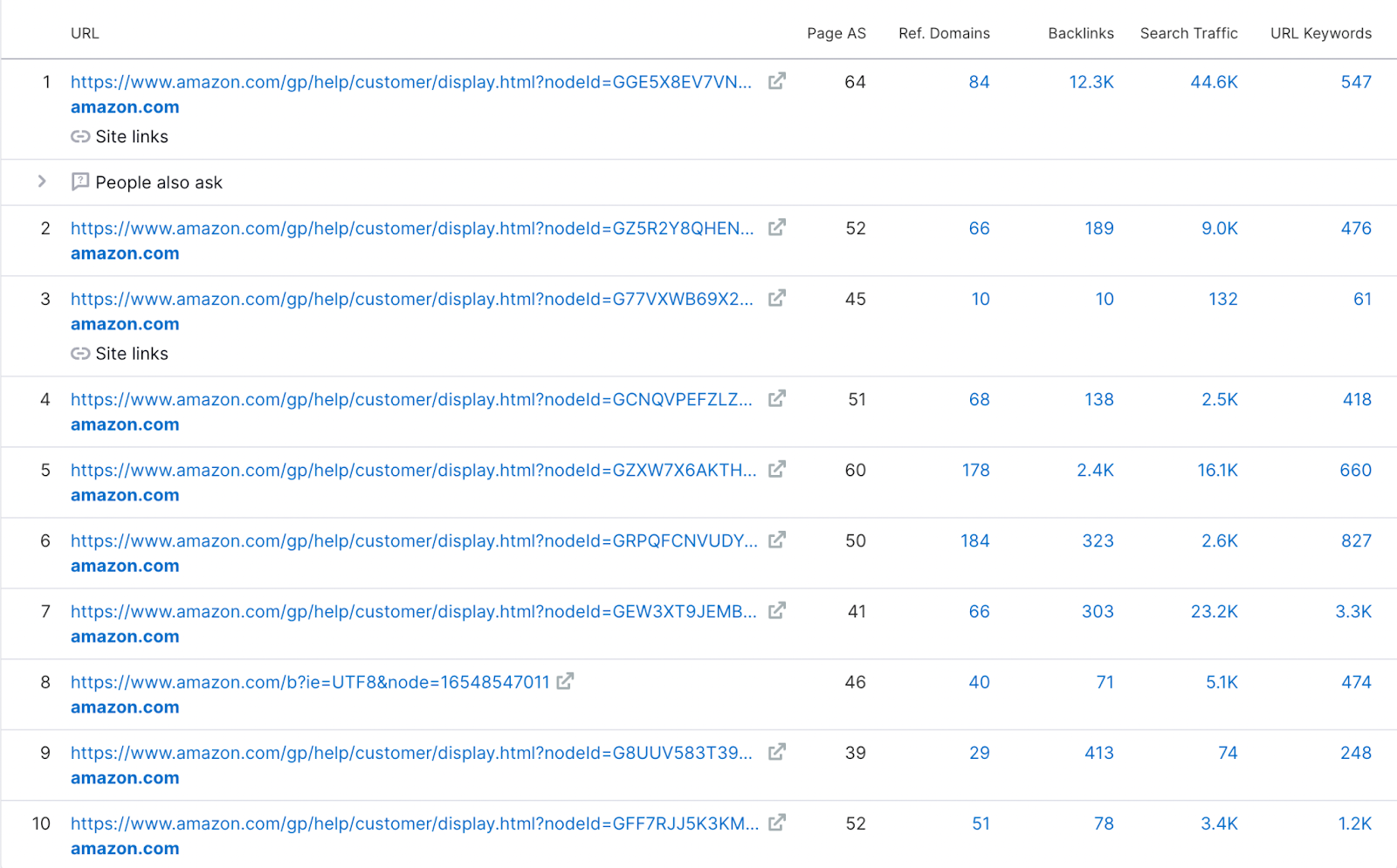
In this case, the top 10 results are all from Amazon’s website.
Which means users want to see information from Amazon. So, if you’re not Amazon, you probably shouldn’t try to rank for this keyword.
Here’s another example: “make coffee at home.”
Once again, go to the Keyword Overview tool and type in the keyword. Then, click on the “Search” button.
You’ll see that the intent of this keyword is informational.
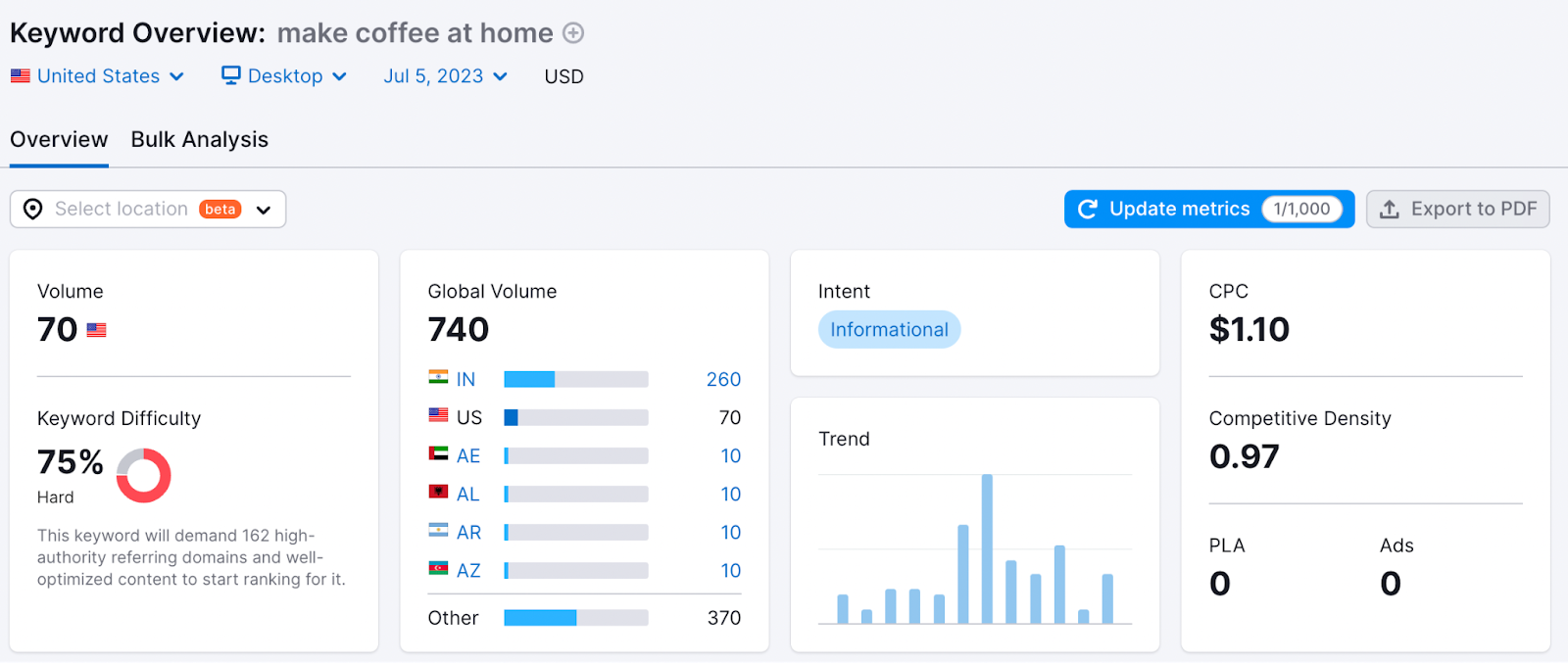
To find out whether you should target that keyword, scroll down to the “SERP Analysis” section.
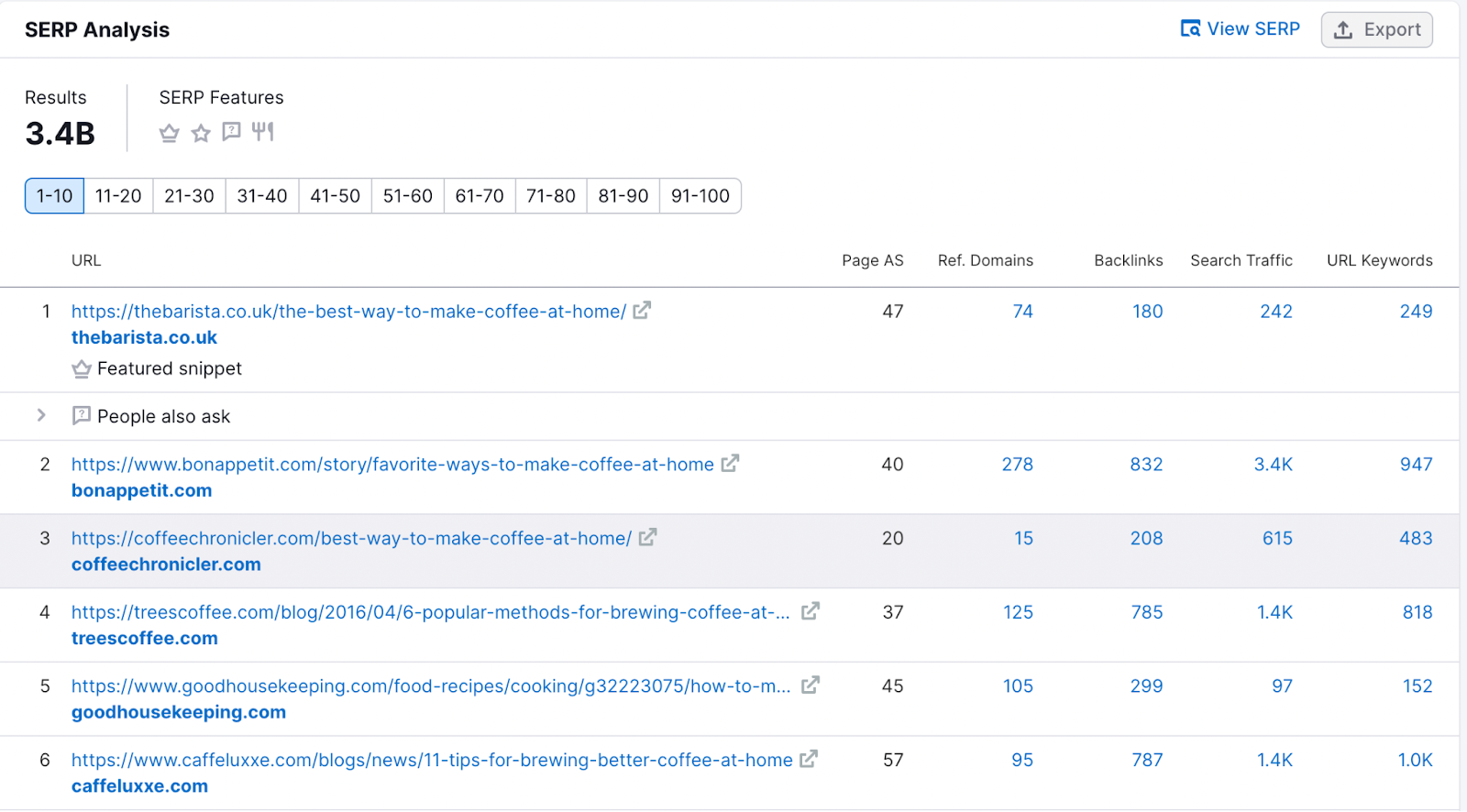
The top 10 results all contain recipes.
So, if you want to target this keyword, you should probably create a recipe page or a video about how to make coffee at home.
To create the best possible piece of content, study the top-ranking results to see what makes them stand out and what the user wants to see.
Use the Keyword Magic Tool to Get More Keywords with the Right Intent
The Keyword Magic Tool pulls up a list of keywords related to your seed keyword. You can then use filters to get a list of related keywords with specific intents.
Let’s say you want to find out what the most popular navigational keywords for your brand are.
Go to Keyword Magic Tool. Type in your brand name and click on the “Search” button.

Above the list of keywords, click on the “Intent” filter. A drop-down menu will appear; select “Navigational.”
Then click on the “Apply” button.
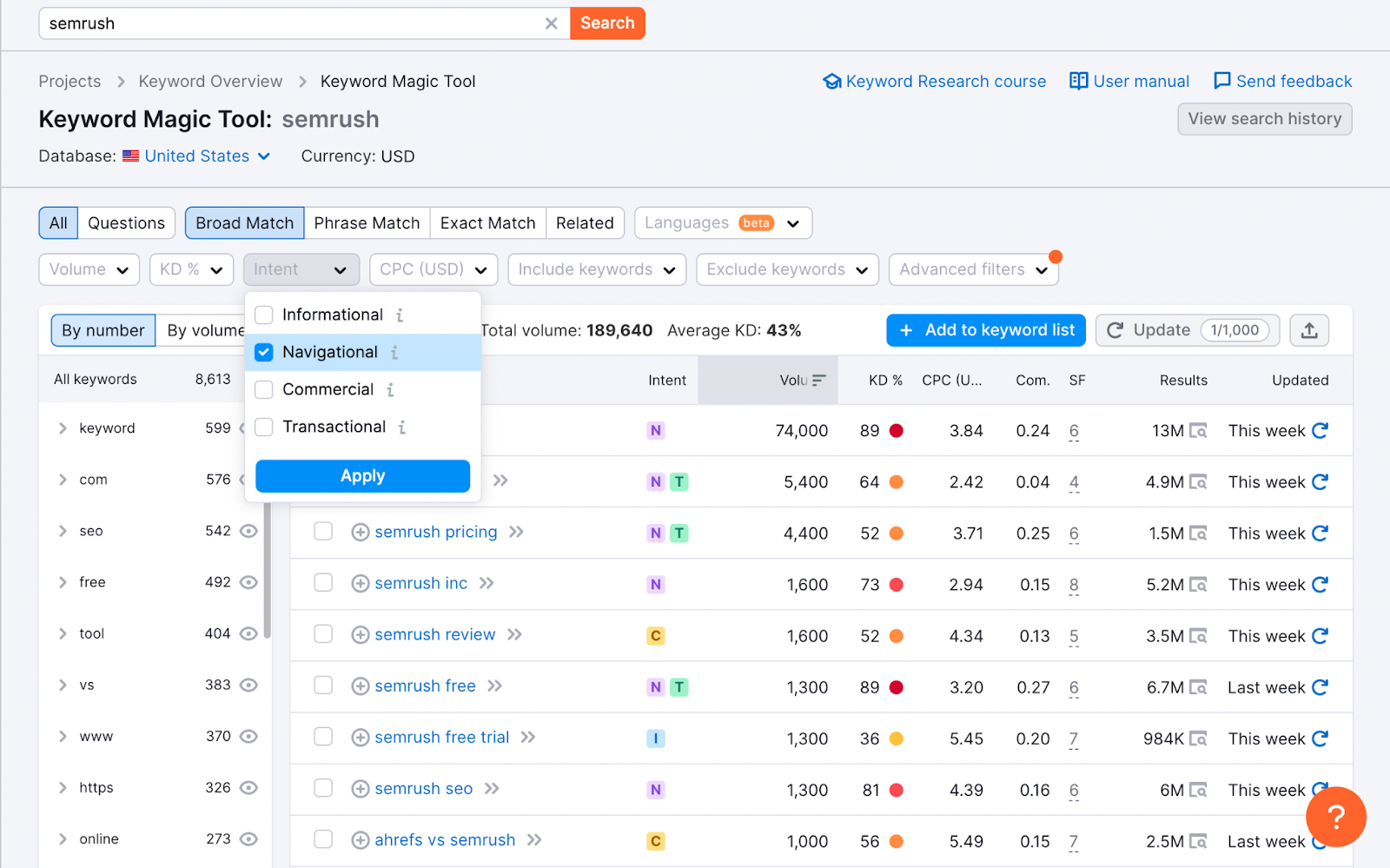
You’ll get a list of all the navigational keywords related to your brand.
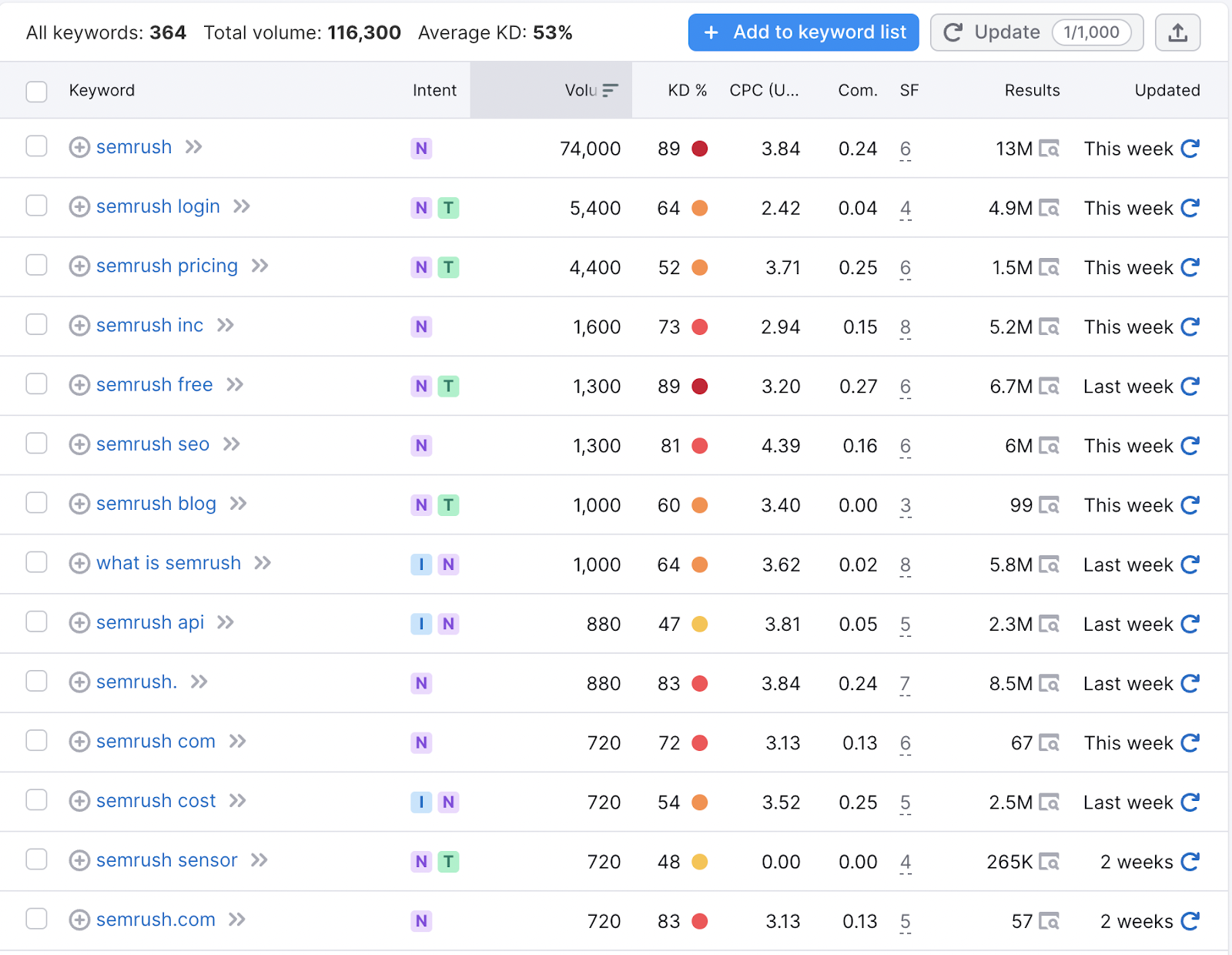
This intent filter in the Keyword Magic Tool is very useful when you’re doing keyword research.
You can see the keyword intent in the “Intent” column and group keywords based on that.
This will save you time and help you plan your SEO strategy.
How Semrush Identifies Keyword Intent
To give each keyword an intent value, Semrush uses a machine-learning algorithm that looks into the following factors:
- SERP features present in keyword search results
- The presence of words in the keyword that indicate the mood/intention of the user (for example: buy, address, how)
- Whether the keyword is branded or not branded
Some common indicators include:
|
Words & SERP Features Semrush Uses to Identify Keyword Intent |
||||
|
Navigational |
Informational |
Commercial |
Transactional |
|
|
Words Included in Search |
Brand names |
How, what, tutorial, why |
Best, review, comparison |
Price, buy, near me |
|
SERP Features & Appearance |
Sitelinks, knowledge panel, the number of times a business domain appears in the top 10 results |
News, recipes, knowledge panel, featured snippet |
Local pack, Google Ads, jobs, review stars |
Popular products, shopping results |
Take note:
A keyword can have more than one intent.
For example, a keyword with informational intent could also have a commercial or navigational intent.
In fact, the keyword “12 string guitar” has both informational and commercial intent.

Refresh Your Content With Keyword Intent In Mind
Keyword intent can make the difference between your content ranking well and getting buried in search results.
Keep keyword intent in mind while doing keyword research and creating content to appear on the right results pages.
Speed things up with Semrush’s keyword research tools, like:
- Keyword Overview: Get tons of data on a specific keyword, including search intent
- Keyword Magic Tool: Get a list of thousands of relevant keywords, along with their search intents
You can test both tools out without a paid plan—simply sign up for a free trial.
To learn more about keyword intent, have a look at these articles:
Source link : Semrush.com
